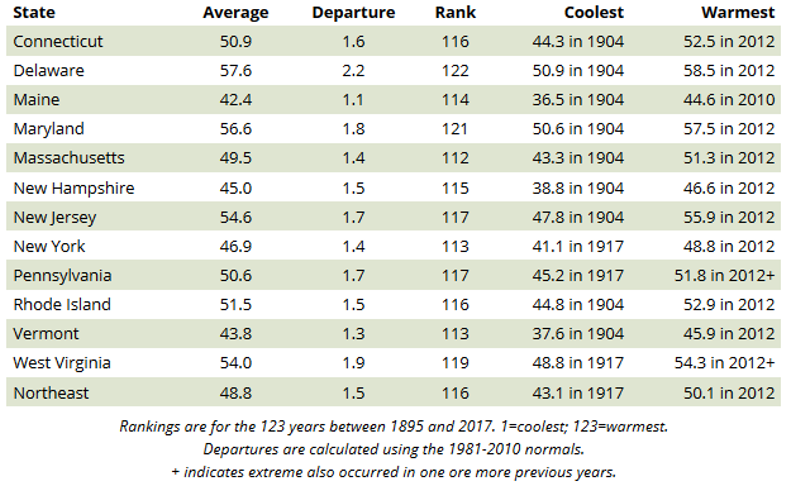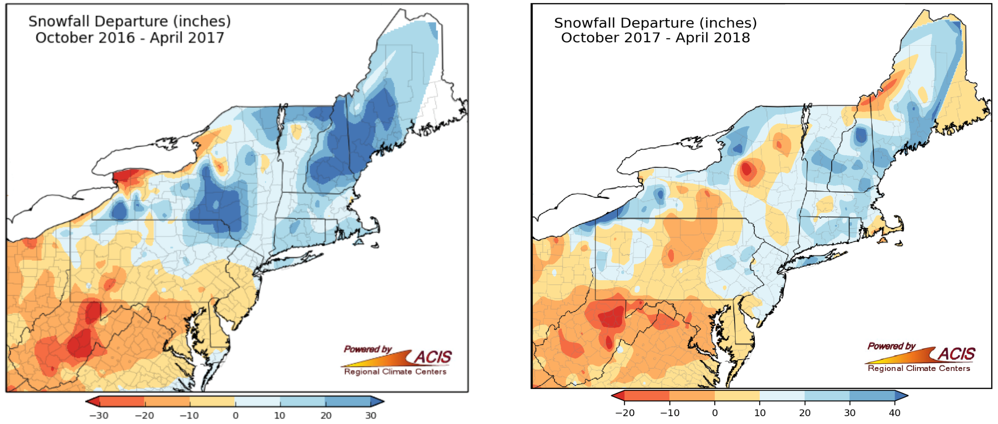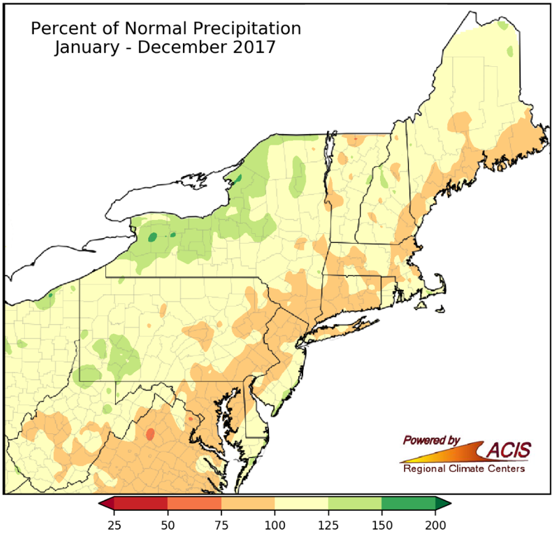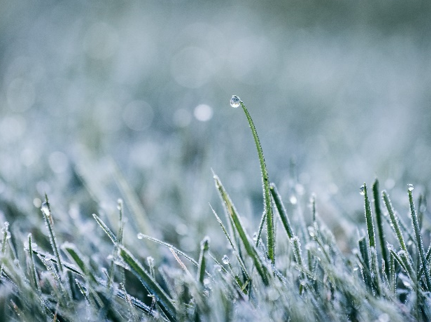Climate
Climate Monitoring in the Northeast
Weather and climate are related but very different phenomena. Weather describes the the condition of the atmosphere (e.g., temperature, rainfall, snow) over the short term, while climate refers to longer-term trends and seasonal patterns. Without long-term weather records it would be impossible to tease out short term (i.e., yearly) anomalies from more ecologically significant climate trends, which makes this information critical to scientists and planners.
The Data
The Northeast Regional Climate Center1 (NRCC) provides detailed information on trends in climate and weather for the Northeast. We expanded the climate summary for 2017 beyond the FEMC monitoring stations in Vermont to include trends from the surrounding 11 states (Maine, New Hampshire, New York, Massachusetts, Connecticut, Rhode Island, New Jersey, Pennsylvania, West Virginia, Delaware, and Maryland) using records from the NRCC. This regional summary provides a broader picture of emerging trends across a larger region. Much of the following regional summary is adapted from the NRCC annual summary2.
2017 in Summary
The climate pattern in the Northeast during 2017 is generally one of warmer than normal temperatures (Table 1) with extreme local precipitation events (Figure 12). Most areas emerged from a warm winter to a cool spring. Although there were local extreme snow events, the winter did not follow a single trajectory across the region.
The region’s average temperature was 48.8°F, which was 1.5°F above normal (Table 1). Nine out of twelve states ranked 2017 among their top ten warmest years on record. The year started with a warmer than normal winter: winter 2016-17 was the fifth warmest on record for the Northeast with an average temperature of 30.6°F (4.7°F above normal). Five out of six New England states each had at least a fifth warmest winter on record, while Maryland, New York, Pennsylvania and West Virginia all had at least their third warmest winters. Snowfall varied across the region, with five states (Maine, New Hampshire, New York, Pennsylvania and West Virginia) receiving above average snowfall (Figure 11).

The 2017 spring was slightly warmer than average for the Northeast, with an average temperature of 46.0°F , which is 0.5°F above normal. Notably, several states had a very warm April, with record high temperatures in nine out of 12 states. The 2017 summer months were slightly cooler than average, with an average temperature of 67.3°F, 0.4°F below normal. The entire Northeast had cooler August than normal, with all 12 states experiencing temperatures ranging from 0.5 to 1.7 below normal. The cool summer was followed by the fifth warmest autumn on record with an average temperature of 52.4°F, 2.6°F above normal. Three of the New England states had record high average temperatures, while the others had their second warmest autumn on record.

Rainfall

The Northeast wrapped up 2017 with an average of 46.35 inches of precipitation, 1.91 inches above the long term average (Figure 12). Four states (Connecticut, Maryland, Massachusetts, New Jersey) were slightly drier (1.45-5.48 inches below average), while nine states had slightly wetter (0.02-3.20) than normal years. Notably, New York had one of its top ten wettest years (Figure 12).
Above-normal rainfall contributed to a cool and wet spring, and made 2017 the fifth wettest on record. Summer continued to be wet with 0.8 inches of precipitation above normal, while a dry autumn rounded out the year with below average precipitation.
Implications
While climate variability is high, both temporally and spatially, meteorological measurements witnessed across the Northeast are in agreement with local and national assessments indicating that temperatures have increased over the past several decades (Betts, 2011; EPA, 2014; IPCC, 2014). However, it is not the general warming trends that will likely impact forested ecosystems the most in the near future. Instead, it is the increased frequency and severity of extreme climate events that are of concern for forest ecosystem condition. The increase in extreme temperatures witnessed in 2017 are an example of the increase in variability we will continue to see under a changing climate. These extremes represent an additional stress for species adapted to cold weather dormancy, increased risk of winter injury following winter warm spells, and frost damage during spring freeze events. Even when climate conditions remain within a species’ natural tolerance, differences in competitive advantages among species due to phenological changes or erratic and unseasonable temperature fluctuations could alter ecosystem structure and function (Pucko, 2014).

Overall, 2017 meteorological measurements in the northeast show increased variability, following the local and national assessments indicating that temperatures have increased over the past several decades. These variable temperatures potentially increase vulnerability to species adapted to cold weather dormancy.
A special thank you to NOAA and the Northeast Regional Climate Center at Cornell University for the use of their regional data and their generous permission to adapt their regional climate summary.
References
- Betts, A. K. 2011. Climate Change in Vermont (unpublished report). Available online: http://www.anr.state.vt.us/anr/climatechange/Pubs/VTCCAdaptClimateChangeVTBetts.pdf
- EPA Climate Leaders Summit Report. Summit Date: Friday, November 8, 2013 Johnson & Wales University, Harborside Campus, Providence RI. Report Date: March 2014. Available online: http://www3.epa.gov/region1/climateleaderscollaboration/pdfs/ClimateLeadersSummitReport.pdf
- Grubinger, V. 2011. Climate Change and Vermont Agriculture. University of Vermont Extension. Available online: http://www.uvm.edu/vtvegandberry/factsheets/climatechange.html
- Intergovernmental Panel on Climate Change (IPCC) Climate Change 2014 Synthesis report Summary for Policymakers. IPCC, 2014: Climate Change 2014: Synthesis Report. Contribution of Working Groups I, II and III to the Fifth Assessment Report of the Intergovernmental Panel on Climate Change [Core Writing Team, R.K. Pachauri and L.A. Meyer (eds.)]. IPCC, Geneva, Switzerland, 151 pp. Available online: http://www.ipcc.ch/pdf/assessment-report/ar5/syr/AR5_SYR_FINAL_SPM.pdf
- Pucko, C. 2014. The Impacts of Multiple Anthropogenic Disturbances on the Montane Forests of the Green Mountains, Vermont, USA. University of Vermont, Department of Biology Ph.D. Thesis.
- Rustad, L. et al. 2012. Changing Climate, Changing Forests: The Impacts of Climate Change on Forests of the Northeastern United States and Eastern Canada. Gen. Tech. Rep. NRS-99. Newtown Square, PA: U.S. Department of Agriculture, Forest Service, Northern Research Station. 48 p. Available online: http://www.fs.fed.us/nrs/pubs/gtr/gtr_nrs99.pdf
Additional Resources
- Vermont State Climatologist: http://www.uvm.edu/~vtstclim/
- Northeast Regional Climate Center (NRCC): http://www.nrcc.cornell.edu/
- NRCC Data Online: http://climod2.nrcc.cornell.edu/
- NOAA Climate At A Glance: https://www.ncdc.noaa.gov/cag/time-series/
FEMC Project Database Link
- Burton Island meteorological monitoring https://www.uvm.edu/femc/data/archive/project/burton-island-meteorological-monitoring
- Colchester Reef meteorological monitoring https://www.uvm.edu/femc/data/archive/project/colchester-reef-meteorological-monitoring-38-m
- Diamond Island meteorological monitoring https://www.uvm.edu/femc/data/archive/project/diamond-island-meteorological-monitoring
- Mount Mansfield east slope mid elevation forest meteorological monitoring https://www.uvm.edu/femc/data/archive/project/mt-mansfield-east-slope-mid-elevation
- Mount Mansfield summit meteorology https://www.uvm.edu/femc/data/archive/project/mount-mansfield-summit-meteorology
- Mount Mansfield west slope mid elevation forest meteorological monitoring https://www.uvm.edu/femc/data/archive/project/mt-mansfield-west-slope-mid-elevation
- Proctor Maple Research Center meteorological monitoring https://www.uvm.edu/femc/data/archive/project/proctor-maple-research-center-meteorological-monitoring
